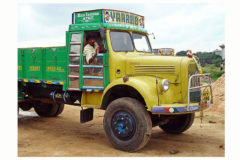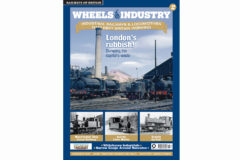The Foden S10 Mk3 4×2 tractor
Posted by Chris Graham on 6th May 2020
Mark Gredzinski charts the history of the Foden S10 Mk3 4×2 tractor; the first model produced once American concern Paccar had bought the struggling, Cheshire-based truck maker.
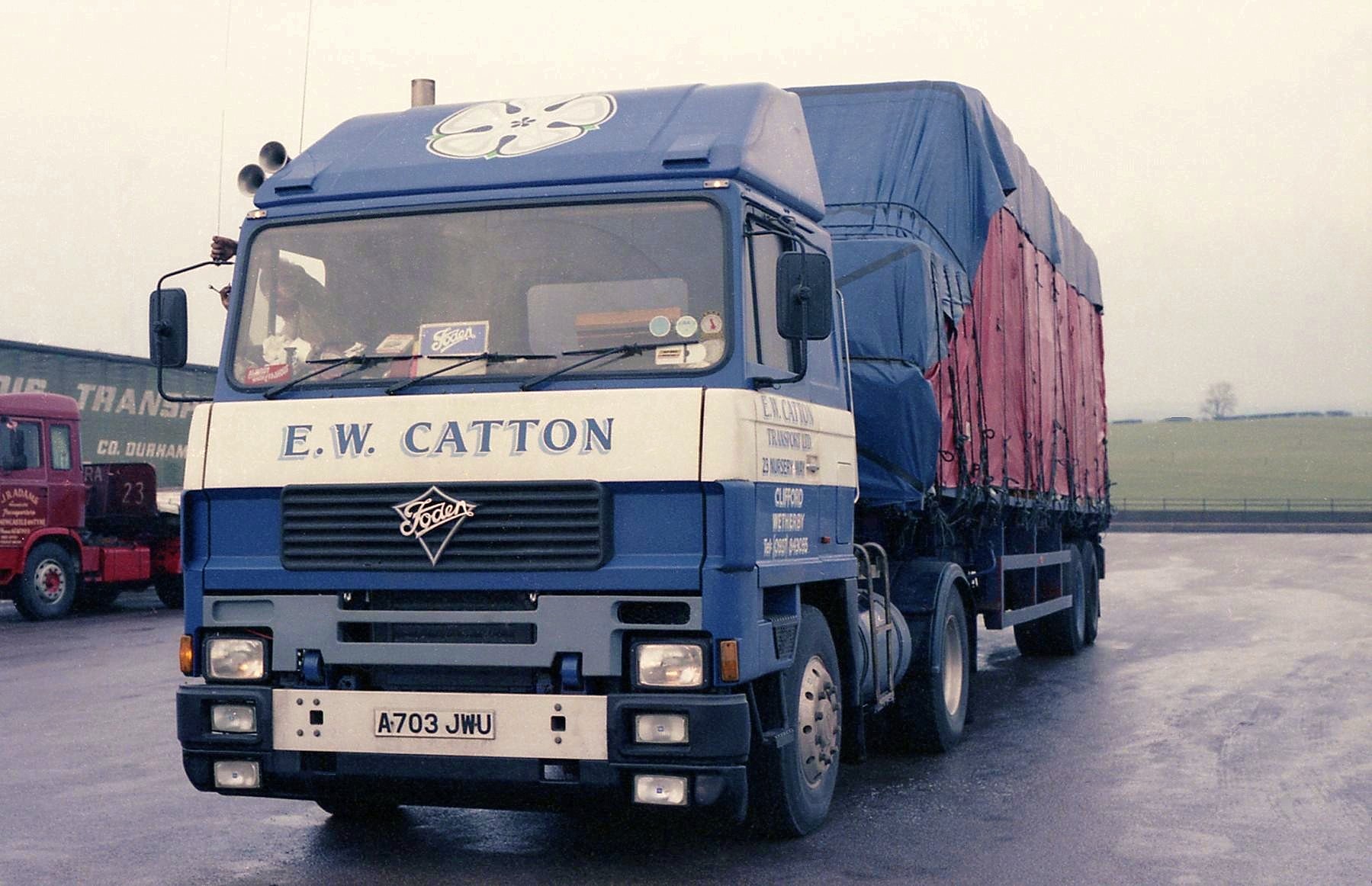
The Foden S10 Mk3 4×2 tractor: EW Catton of Clifford, near Wetherby in W. Yorks, ran at least two Mk3s, with a high roof option. This 1984 example was photographed about a year after manufacture, at a motorway services. I seem to recall it was a drizzly Sunday, and the driver is making an adjustment to his aerial!
Foden’s decision to invest heavily in a new, larger, £5million production facility during the 1970s was certainly the right thing to do for the company. It provided the capacity to produce up to 6,000 trucks a year but that advantage didn’t last long as, unbeknown to Foden, recession loomed and with it would come the collapse of orders.
The economic consequences were certainly harsh, with £1.7million trading losses by January 1980 and, eventually, the shedding of nearly 2,000 jobs. Foden (to be renamed Sandbach Engineering), was then run by newly-installed Paccar MD, Hank Kiefer. Like Foden, Paccar made premium trucks, with marques like Kenworth and Peterbilt placing the emphasis on lightweight vehicles combining pizazz and quality.
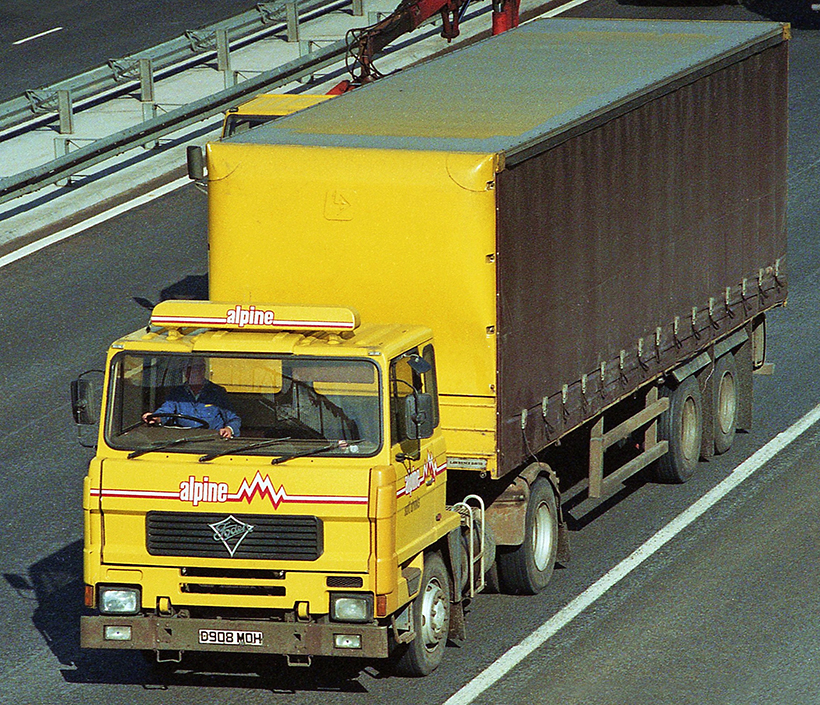
The selling of fizzy pop, door-to-door, was popular in the 1980s. Alpine soft drinks used to use a few Foden drays, including S80 and S108 eight-leggers, plus Bedford TK four-wheelers on more local work. This 1987 S104 articulated dray was seen on the M5 in West Bromwich, back in March, 1990.
Optional extras
A crucial difference, though, was that the American manufacturers offered customers a large array of custom options, so they could get the specification of truck they really wanted. It was felt that this approach could now work in the UK. A criticism of certain British manufacturers in the past had been that there was an arrogant, ‘like it or lump it’ approach to truck spec, which often ultimately saw customers looking elsewhere to find a better match with what they needed. The new owners were also advocating American-influenced 6×4 double-drive tractors over most manufacturers’ 6×2 configuration for 38-tonne operation, covered later, together with the S108 rigid eight-wheelers.
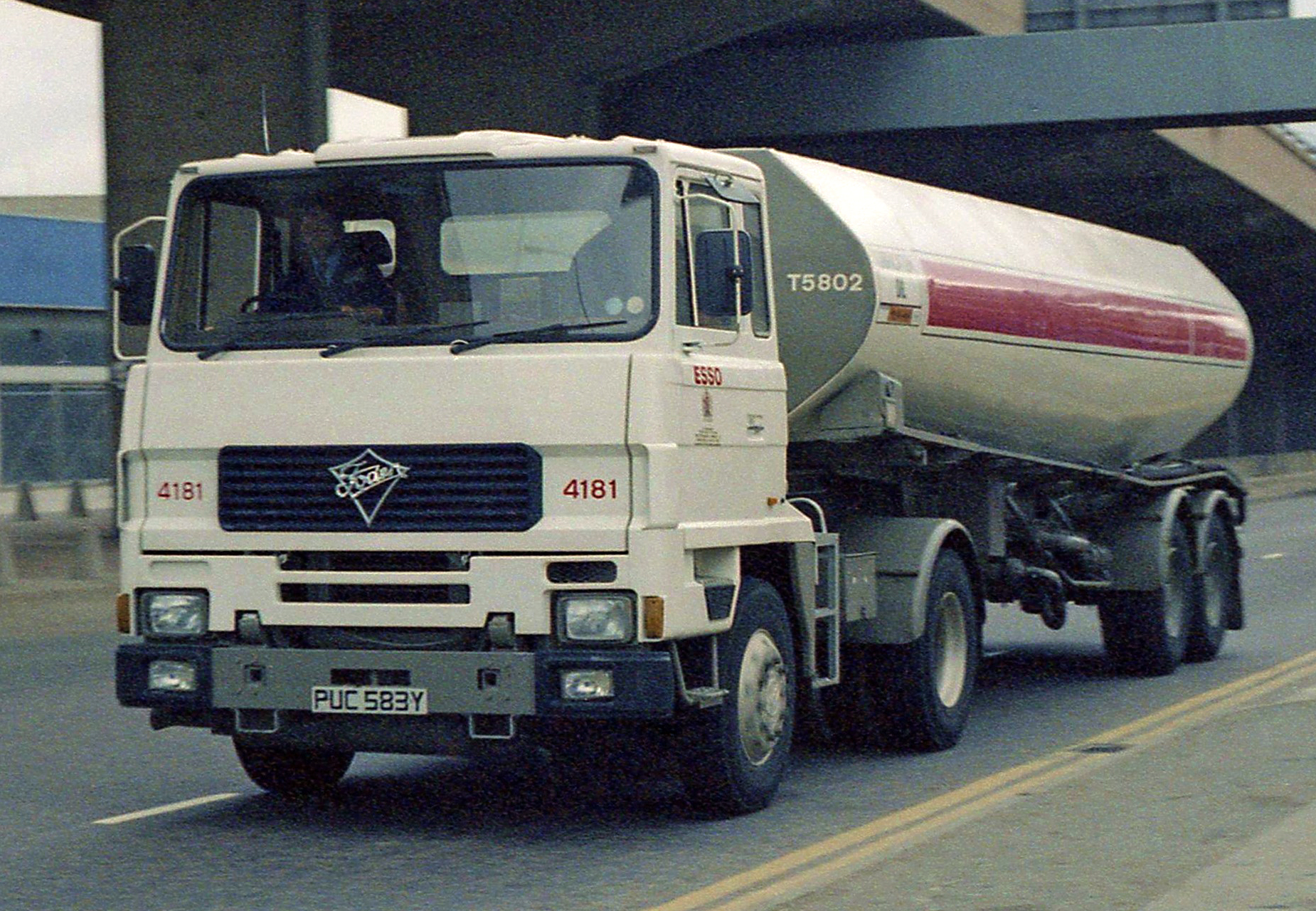
Typical of fuel tanker use was this S104 operated by Esso. I photographed it under the Gravelly Hill Interchange (Spaghetti Junction), in north Birmingham. This 1983 tractor fitted well to the dimensions of the tanker and, like many petroleum companies, Esso specified a light unit with weight-saving aluminium wheels and super singles on the trailer. The shot was taken in September, 1985.
The S10 cab had a strong, steel frame, with bonded GRP composite panels on top. This had last seen use in the Fleetmaster tractor range, that had been updated marginally with the stop-gap Mk2 version which had new front air deflectors and a simple grille with the Foden script and kite logo in bright metal trim. For the S10 Mk3 cab in 1983, the front-end received a rather cheap-looking, smaller black plastic grille, no trim surround and a smaller ‘Foden’ badge.
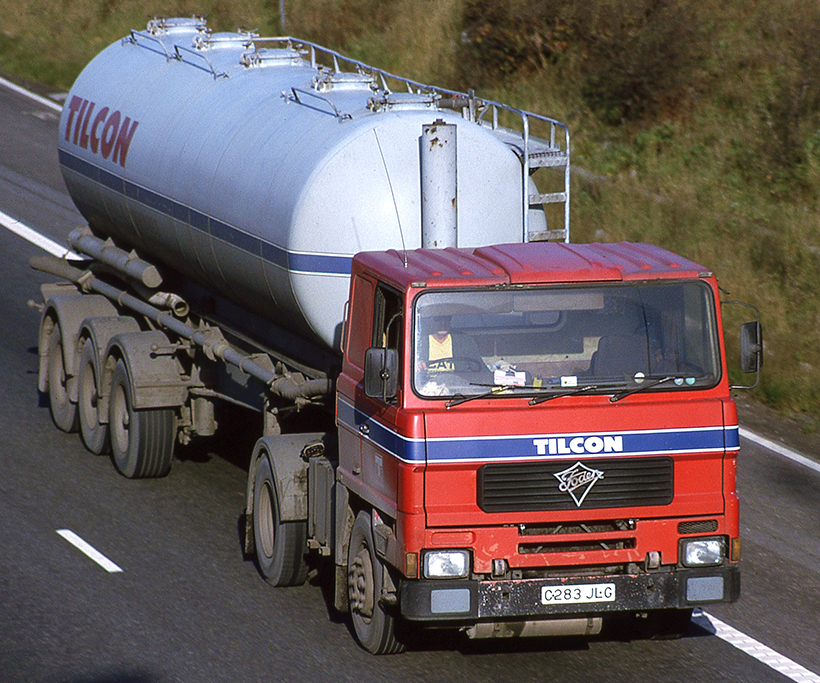
I had a choice of three Tilcon Foden shots to choose from, one of which sported Gardner turbo badges. I’m not sure of the engine in this S10 photographed on the M6, in November, 1993. Tilcon had a long history of Foden use for its cement tankers and concrete mixers, and this 1986 example was run in conjunction with Foden S108 rigid eight-wheelers.
Elaborate history
Considering the Foden heritage of elaborate styling and the perceived glamour of Kenworth, with polished and plated adornments, I always thought of this as a retrograde step. The new front-end panels were flat and boxy, in keeping with 1980s styling trends, and the front axle was set back. This gave improved cab access, but the resultant angular styling looked more kooky than handsome. On the plus side, the 75-degree tilting cab was spacious and comfortable with decent seating, good ergonomics and a double bunk option.
Door panels were aluminium as were many chassis castings, including cross-members. The Paccar influence from Kenworth and Peterbilt saw to that. Engine variety included Cummins Super E320 and 350, plus Rolls-Royce Eagle 300, 320 and 340 diesels, coupled with five gearbox and four rear axle choices. Options included differing wheelbases, aluminium or steel fuel tanks, various exhaust positions and three-wheel varieties. A standard spec was a Cummins NTE 290 with a 14in Lipe Rollway clutch, a Fuller RTX gearbox and Rockwell R170 back axle. Some of the early catalogues had the tractors looking a little ‘plain Jane’ in photographs which, again, in light of the potential American visual appeal on their trucks, was somewhat surprising.
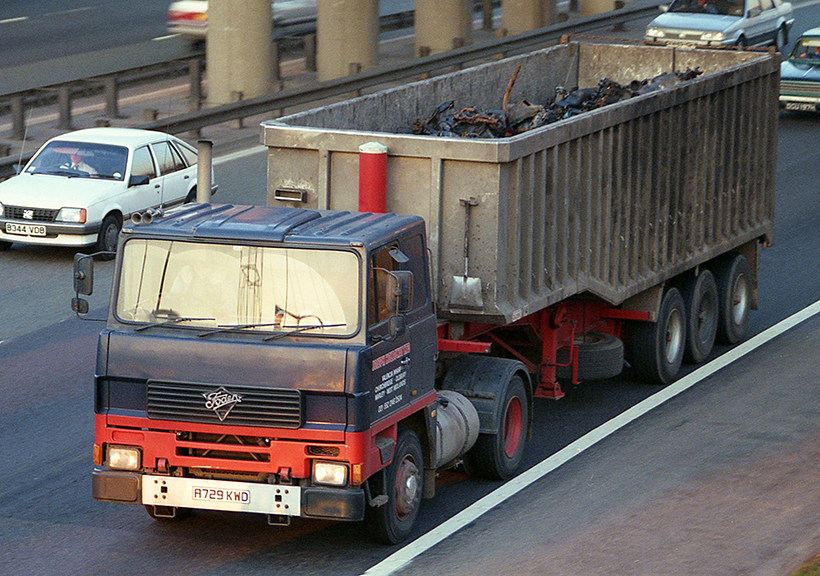
From Oldbury in the West Midlands, Joseph Holloway used to have a yard full of S104 and S108 Fodens, largely on scrap-metal duties. It had Fodens up to the last Alphas, then Scanias and now favours Renaults painted white. This 1984 S104 was photographed in Great Barr, Birmingham on Junction 7 of the M6, in 1989. Its aluminium-bodied trailer is piled high with dirty scrap… or, ‘recycled metal’ as we like to say in these enlightened times!
Favourite tractor
The 4×2 configuration found favour with oil companies, and Foden was keen to specify a tractor that would have a low unladen weight, which is what operators like Shell and Esso were after. Wincanton ordered 45 S104 32.5-tonne tractors and Tilcon operated a few on bulk cement; some with Gardner power. Other users included Scottish operator MacBrayne Haulage, with Rolls-Royce Eagle tractors, Jefferies of Ottley used a few in its attractive, green livery, Alan Lodge, Royal Mail, Steetley hauling bricks, Robbins of Swansea, United Molasses and British Salt.
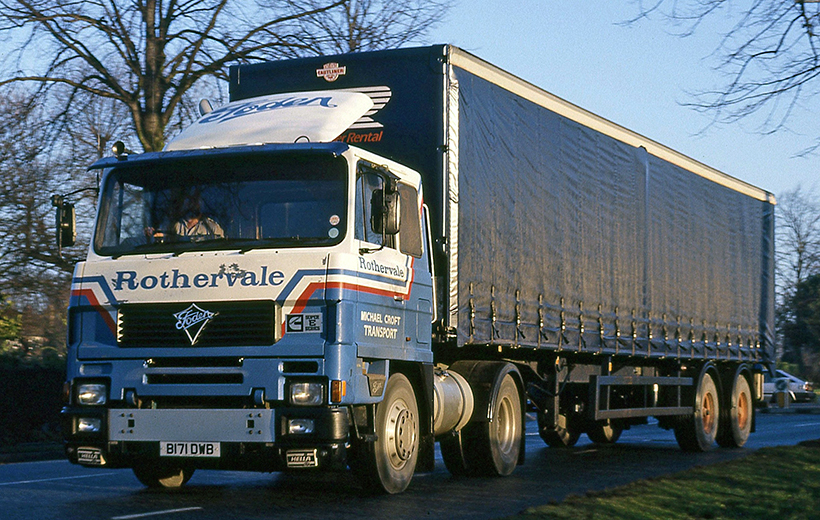
I’m not sure of the origins of Rothervale or its operator, Michael Croft Transport, but this 1985 Foden was photographed near me in Walsall in February, 1988. Pulling a Boalloy Tautliner, the Cummins Super E-powered tractor appears to be in the Foden livery featured in a mid-1980s sales brochure, so may possibly have been a demonstrator at one point.
But the S104 Mk3 tractor was never going to be the saving grace of Foden and, in some ways, more attention should have been paid to its visuals to make it more appealing. But it performed its hauling roles well, and better was to come as the new company stabilised. The Mk3 was replaced by the more sophisticated 4000 Series (named because it was the fourth generation of the S10 cab, since Paccar took over Foden) in May 1987, with better aerodynamics and a cleaner look.

Based in the Potteries I believe, this Cummins 320-powered S104, run by Steve Poole, could well have been on scrap metal duties. It was photographed in early March, 1990, on the Tyburn arterial road in north Birmingham.
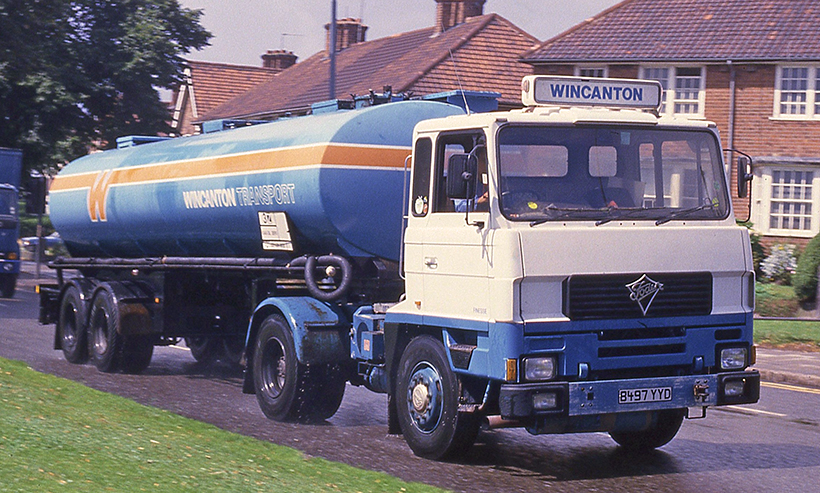
Wincanton Transport used many Foden S10 tractors, and one of its machines appeared in Foden advertisements. This tanker was captured at speed on the Tyburn Road in Erdington, Birmingham. Spray is emitting from the tyres as the lorry made progress following a spell of summer rain in July 1988.
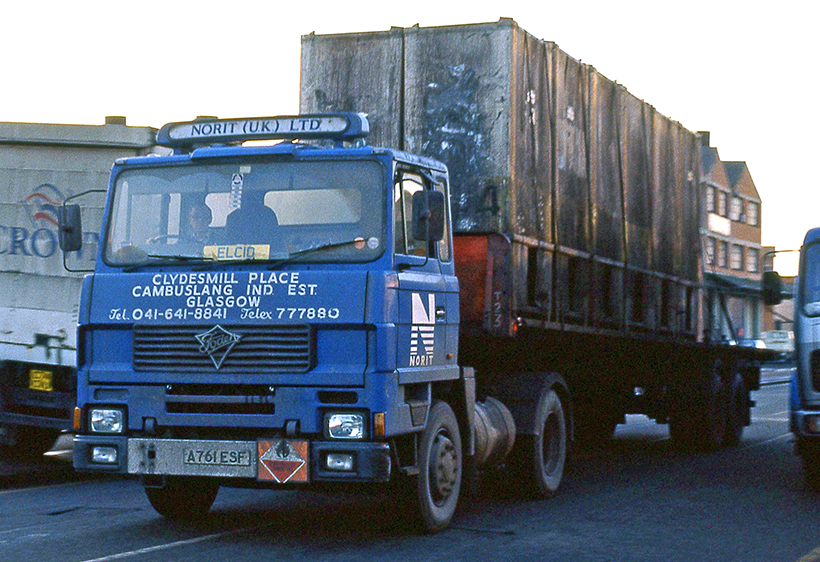
In December 1989, I was dropped off by a customer of mine in Trafford Park, Manchester, which gave me the opportunity to take some lorry pictures in a district new to me. Along the way, I captured this Glasgow-based 1984 Foden S104, belonging to Norit Ltd which does water purification among other things.
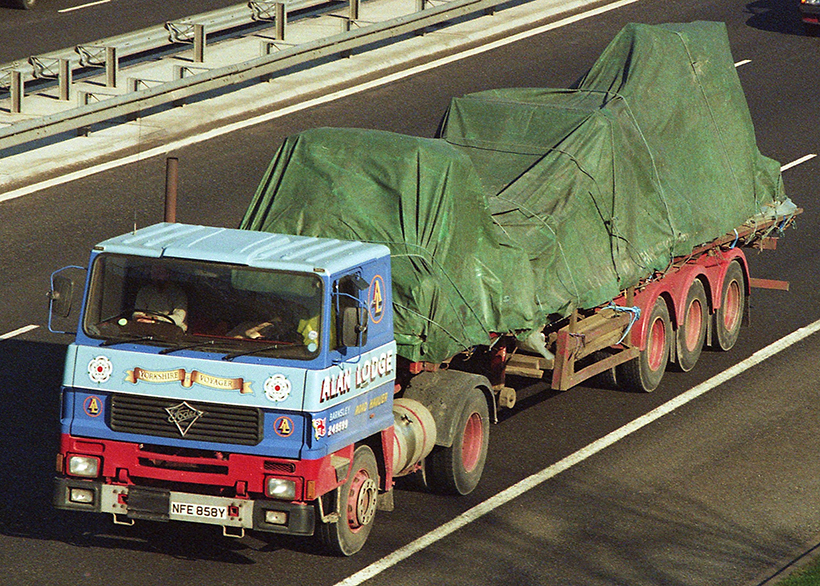
If there’s one way to improve on a photograph of a roped and sheeted load, it’s having it pulled by a characterful and well-liveried lorry like this one. Alan Lodge was based in Barnsley, and used to run at least a pair of these S104 tractors. This 1983 example, called Yorkshire Voyager, was captured on the M6 around 1989.
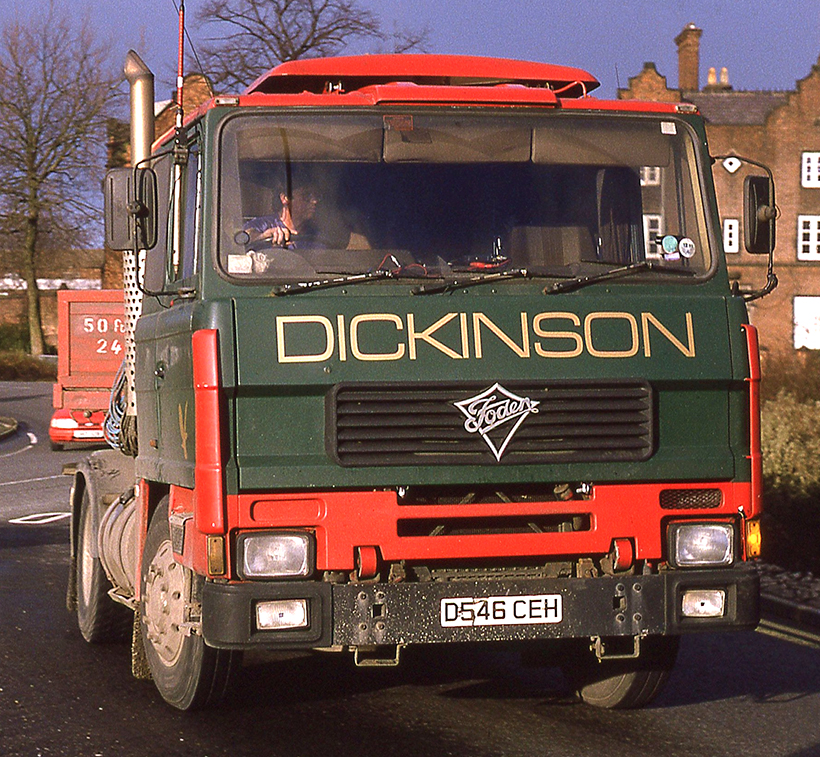
John Dickinson Transport of Darlington in the North East, has been going since the 1950s. The company has run both ERFs and Fodens – up to the last Alpha models – in the past. Specialising in the heavier end of haulage in the main, it now has the usual MAN and Mercedes suspects in its fleet. This 1987 Foden S104 was photographed one morning in January 1994, about to tackle a fairly steep rise on a Walsall ring road.
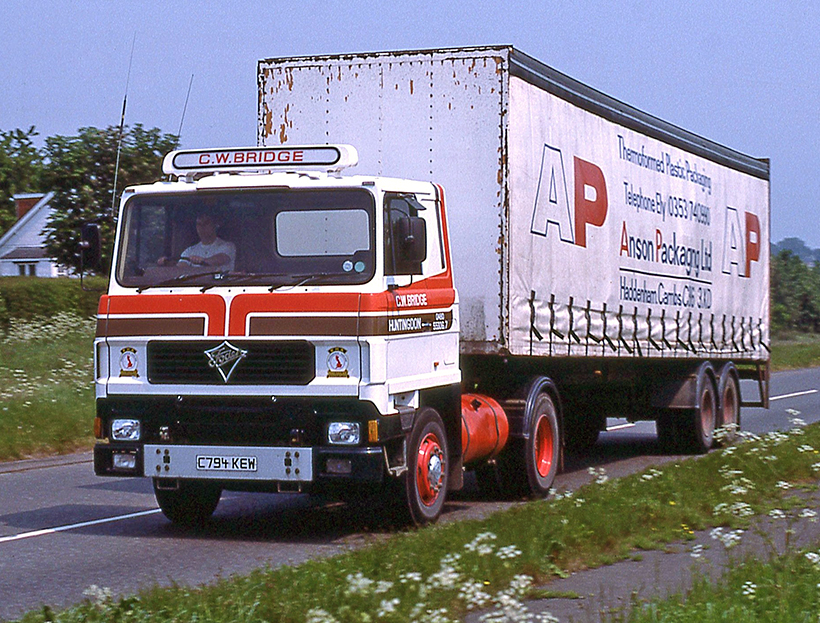
CW Bridge, of Huntingdon in Cambridgeshire, ran a few Fodens including the predecessor to this 1986 Foden S104, the Fleetmaster tractor. This machine was photographed slowing for a roundabout on the A5 in Staffordshire, back in May 1989.
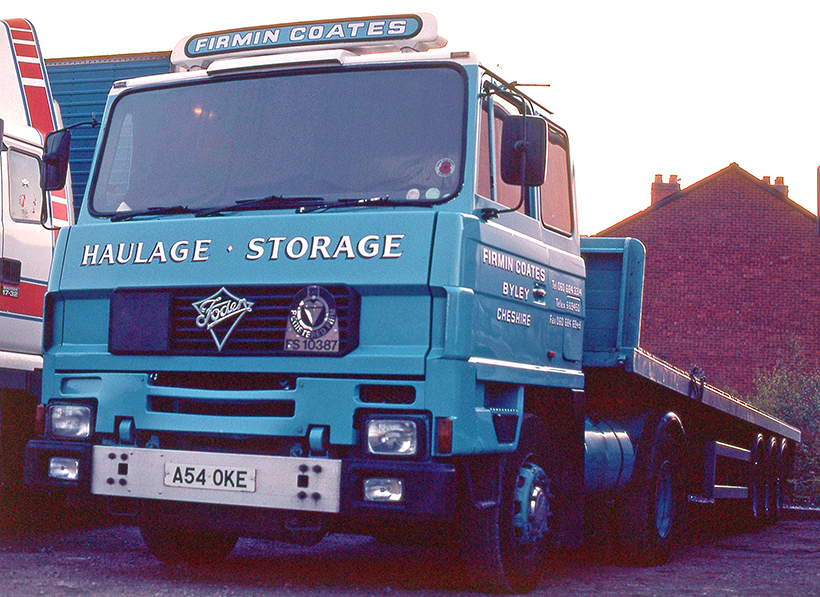
This S104 was captured as the sun was setting, parked in a local lorry park. Firmin Coates, of Byley in Cheshire, used to run both ERFs and Fodens. One of its Fleetmaster tractors was featured in Foden advertising, and this 1984 S104 was photographed in April 1991.
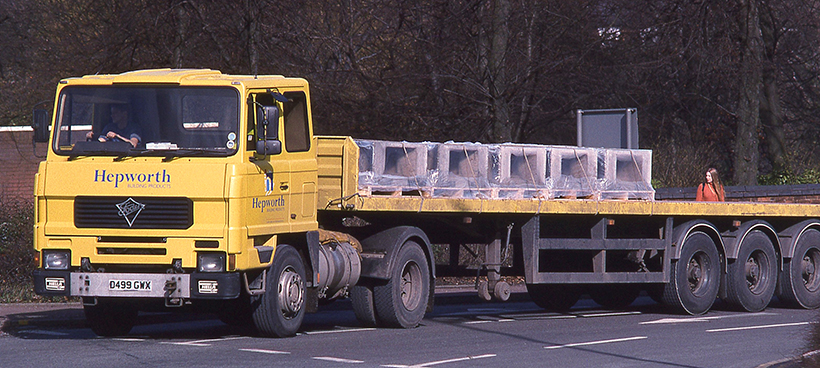
Hepworth Building Products has run out of various depots, and could claim both Foden and Seddon Atkinson trucks in its fleet back in the 1980s. This 1987 Foden would typically carry clay pipes as a load. It was coming to a stop near a roundabout in Walsall, one afternoon in March 1997.
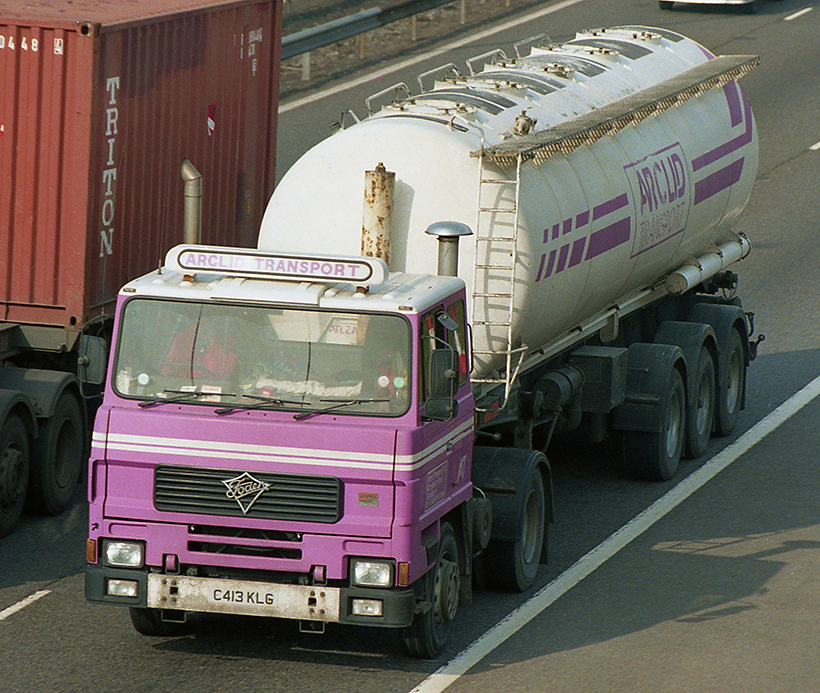
The distinctive purple livery of Arclid Transport is a welcome sight as this operator always runs a tidy fleet. Carrying powder and sand, the Sandbach-based firm has some nicely-painted modern Volvos in the fleet. However, back in the late 1980s (and into the following decade), Fodens dominated, and this 1986 S104 was a typical example. It also ran rigid eights as tankers, and this machine was captured on film in March 1992, while on the M6.
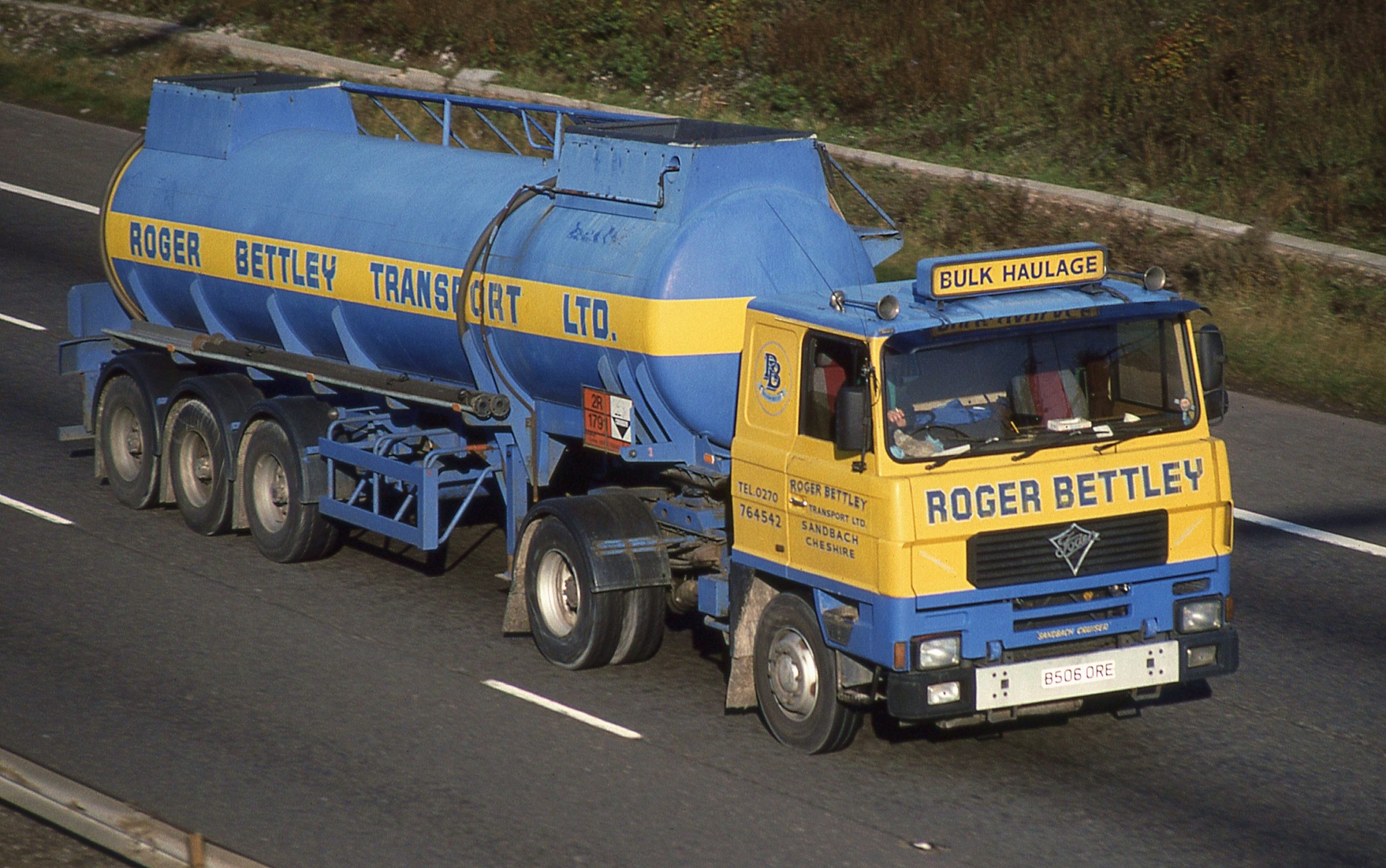
Roger Bettley was based in Sandbach, Cheshire, so Foden was a fairly logical make to use, especially since part of its work involved hauling parts for Foden. It also used tankers, as on this tidy, 1985 S104 called ‘Sandbach Cruiser’. The company also ran an S106 6×4 tractor and later 4000 Series units. This shot was taken in November 1991, on the M6.
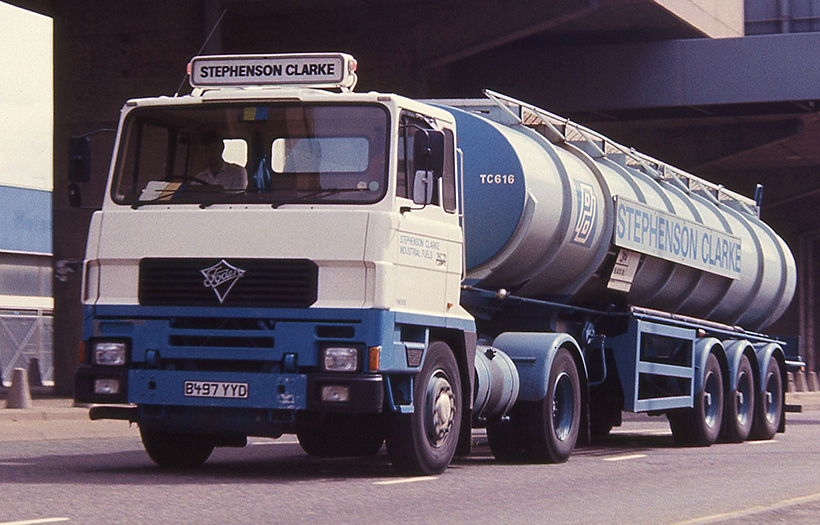
A bright morning in September 1985 saw this quite new S104 at speed, but about to slow down to make way under Spaghetti Junction in Birmingham. It belonged to Stephenson Clarke Industrial Fuels, which is now defunct.
To subscribe to Heritage Commercials magazine, simply click here



